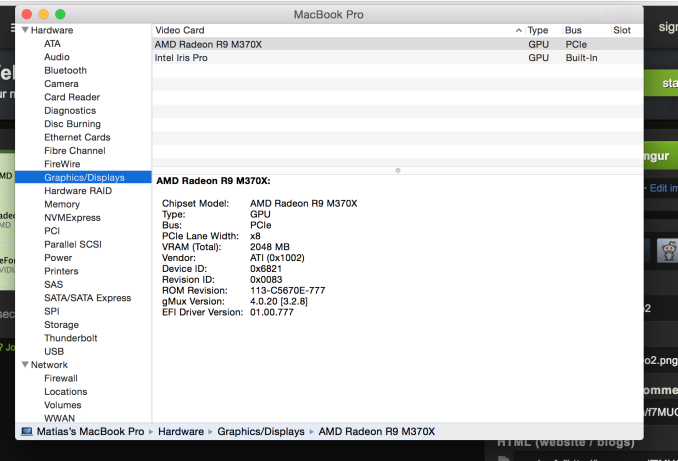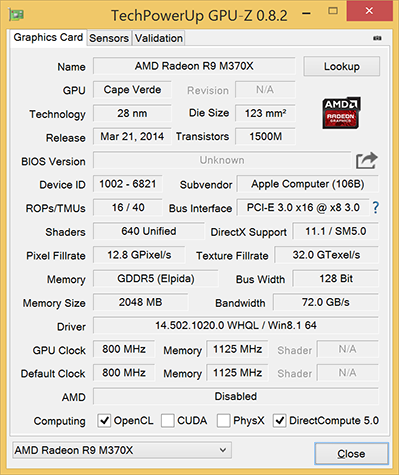2015 15-inch Retina MacBook Pro’s dGPU (R9 M370X) Is Cape Verde
by Ryan Smith on May 23, 2015 12:16 AM EST- Posted in
- GPUs
- Mac
- AMD
- Apple
- MacBook Pro
- Radeon
- Radeon 300

Earlier this week Apple announced their 2015 15” Retina MacBook Pro. Though Apple didn’t make any CPU changes, they did make some GPU changes on the high-end model, swapping out NVIDIA’s GeForce GT 750M for AMD’s Radeon R9 M370X. Since the M370X was not a published part number in AMD’s recently-announced 2015 Radeon M300 series refresh lineup, there have been some questions over just what M370X really is.
At the time of the rMBP’s launch, we suspected that it was an AMD Cape Verde GPU, based on the fact that this GPU is also in the M375, which is the next part above M370X. With the new laptop shipping immediately, M370X models have already begun arriving in buyers’ hands, finally giving us a chance to confirm the GPU inside.

Image courtesy Reddit user ootan
Thanks to Reddit user ootan, who posted a screenshot of the rMBP’s System Profiler, we can now confirm that the GPU in the rMBP is in fact AMD’s Cape Verde GPU. AMD has previously used the 6821 device ID on other mobile Cape Verde parts, so 6821 is already a known quantity.
| AMD M300 Series GPU Specification Comparison | |||||
| R9 M375 | R9 M370X (rMBP) | R7 M360 | |||
| Was | Variant of R9 M270/M260 | Variant of R9 M270X | Variant of R7 M270/M260 | ||
| Stream Processors | 640 | 640 | 384 | ||
| Texture Units | 40 | 40 | 24 | ||
| ROPs | 16 | 16 | 4? | ||
| Boost Clock | <=1015MHz | 800MHz | <=1015MHz | ||
| Memory Clock | 2.2GHz DDR3 | 4.5GHz GDDR5 | 2GHz DDR3 | ||
| Memory Bus Width | 128-bit | 128-bit | 64-bit | ||
| VRAM | <=4GB | 2GB | <=4GB | ||
| GPU | Cape Verde | Cape Verde | Oland/Topaz | ||
| Manufacturing Process | TSMC 28nm | TSMC 28nm | TSMC 28nm | ||
| Architecture | GCN 1.0 | GCN 1.0 | GCN 1.0 | ||
As for Cape Verde itself, as our regular readers may already know, it’s one of AMD’s first-generation GCN 1.0 GPUs, launched back in 2012. Compared to the GK107 GPU found in the GT 750M, it is a larger, more powerful (and at least in the desktop, more power-hungry) GPU, designed for more powerful devices than GK107 was. As for why Apple opted to switch now and to this GPU, we’ll leave that to Apple, AMD, and NVIDIA, though it’s by no means surprising that after having run GK107 for a couple of years, they would want to upgrade to a more powerful GPU.
Meanwhile, though we don’t have M370X on-hand at the moment, at least in the desktop, where GPU performance is unrestricted by thermals, Cape Verde fares very well. The rMBP on the other hand does have thermal constraints to deal with, so performance won’t be the same, but I expect it to fare reasonably well as well. Though at the same time I’m also curious if the use of a higher performance part has impacted the rMBP’s battery life when the dGPU is active; AMD and NVIDIA both do heavy binning, so a simple extrapolation won’t work here.
Update: And no sooner do I post this then someone sends me a screenshot of GPU-Z from a 15" rMBP running Boot Camp.
GPU-Z, for those unfamiliar with it, uses register poking to identify GPUs, so if the device ID wasn't enough, this settles it. This also confirms the clockspeeds - 800MHz core, 4.5GHz VRAM - and that the M370X is using GDDR5, unlike it's M375 counterpart. Thank you DMDrew812.
Source: Reddit User ootan (via SH SOTN)











107 Comments
View All Comments
repoman27 - Saturday, May 23, 2015 - link
GM107 may well provide better performance per watt than Cape Verde or GK107, but AFAIK, the TDP is way higher. As in most online sources claim something like 75 W for the GTX 950M, vs. only 45 W for a Radeon HD 7870M, which the R9 M370X is essentially a rebadge of. This is in line with the type of scaling you'd expect given the transistor counts seeing as everything is on the same process anyway.testbug00 - Sunday, May 24, 2015 - link
um, no. A fully enabled GM107 running at well over 1Ghz uses less power than a 640CU Cape Verde at 1Ghz.http://www.techpowerup.com/reviews/NVIDIA/GeForce_...
The 7770 is @ 1Ghz, the 750ti running 980-1150Mhz, with the average being 1140 across all the games tested. And the 750ti is about 50% faster (7770 is ~66%... 100 divided by 66 == about 1.5)
so, at an average of 1150Mhz, the chip draws 52 watts while gaming. IF you think they cannot easily bin and reduce clockspeeds to get under 45W, you're crazy :)
tipoo - Sunday, May 24, 2015 - link
Those have soft configurable TDPs.halo37253 - Sunday, May 24, 2015 - link
Macbooks are not gaming machines. People don't buy them to play games on them. Pointless to chose a card based solely on gaming performance. They went with the better compute card, simple as that.loguerto - Saturday, May 23, 2015 - link
Apple is very focused on opencl coding, the advantage GCN have on that side probably is why apple choosed AMD over nvidia.dm27 - Saturday, May 23, 2015 - link
How then is this MacBook Pro capable of driving a 5k display (5120-by-2880 @ 60Hz)?repoman27 - Saturday, May 23, 2015 - link
The same way the 27-inch iMacs and Mac Pros can: by using two cables and two Thunderbolt 2 ports.Pneumothorax - Saturday, May 23, 2015 - link
This is pure CHEAPNESS and cynicism in Apple's part in putting a 3 year old outdated gpu in their most expensive laptop. The 950M easily does 30+% faster within the same power constraints as this chip. To add insult to injury, Apple could've dumped these chips in the 1st gen 2012 retina macbook.AMD must me giving these away for free.
V900 - Saturday, May 23, 2015 - link
Yeah but look at the bright side. They won't be in there for long, and will hopefully be thrown in the trash in less than a year when Apple updates their MBP to Skywell CPUs.Think of it as charity. Apple throwing some spare change at AMD, to make sure they won't go tits up before they launch their Zen/K12 CPUs.
A market with competition for GPUs and CPUs is worth a lot more for Apple than what half a year with a mediocre GPU in the top of the line MacBook will cost them.
lilmoe - Saturday, May 23, 2015 - link
"Think of it as charity"Oblivious much?